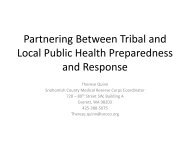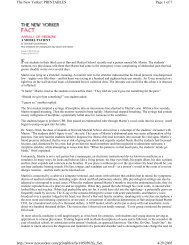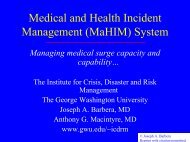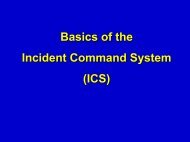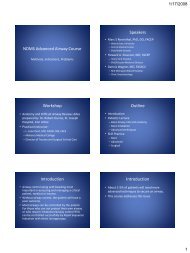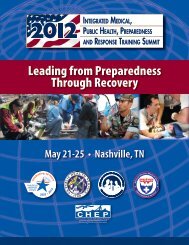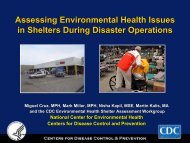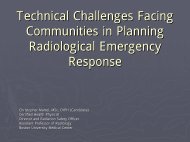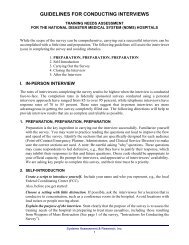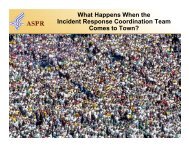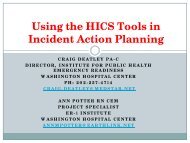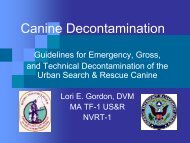Hurricane Scenario: Lessons Learned - The 2012 Integrated ...
Hurricane Scenario: Lessons Learned - The 2012 Integrated ...
Hurricane Scenario: Lessons Learned - The 2012 Integrated ...
Create successful ePaper yourself
Turn your PDF publications into a flip-book with our unique Google optimized e-Paper software.
Patient Movement <strong>Lessons</strong> <strong>Learned</strong>
AGENDA<br />
Welcome<br />
Introduction - <strong>The</strong> Continuum of Patient Movement<br />
Block 1 - Pre-Incident Planning<br />
Block 2 - Patient Movement Response<br />
Block 3 - Post Landfall<br />
Block 4 - <strong>Lessons</strong> <strong>Learned</strong> Discussion<br />
Patient Movement Track – <strong>Lessons</strong> <strong>Learned</strong>
INTRODUCTION<br />
• Panel Members:<br />
• Texas Dept of State Health Services: Rick Bays<br />
• LA Dept of Health and Hospitals: Dr. Roseanne<br />
Prats and Dr. Jimmy Guidry<br />
• Air National Guard: Col Jackie Nave<br />
• VA FCC: William Bossert<br />
• USNORTHCOM: Bill Macchi<br />
• USTRANSCOM: CAPT Corley Pucket<br />
• HHS: Joe Lamana<br />
Patient Movement Track – <strong>Lessons</strong> <strong>Learned</strong>
<strong>Hurricane</strong> Response <strong>Lessons</strong> <strong>Learned</strong><br />
Texas Perspective<br />
2008 Public Health<br />
Emergencies<br />
• Yearning for Zion Ranch<br />
• National Salmonella Outbreak<br />
• 1 Tropical Storm (Edouard)<br />
• 3 <strong>Hurricane</strong>s (Dolly, Gustav, Ike<br />
Patient Movement Track – <strong>Lessons</strong> <strong>Learned</strong>
<strong>Hurricane</strong> Response <strong>Lessons</strong> <strong>Learned</strong><br />
Texas Perspective Successes<br />
• Pre-deployable Teams<br />
• FEMA Ambulance Contract<br />
• Contracted Medical Staff<br />
• Federal & State Integration<br />
– DMAT<br />
– DMORT<br />
– FMS w/staff<br />
– IRCT<br />
– NDMS<br />
Patient Movement Track – <strong>Lessons</strong> <strong>Learned</strong>
<strong>Hurricane</strong> Response <strong>Lessons</strong> <strong>Learned</strong><br />
Texas Perspective Successes<br />
• EPAP & Pharmacy Contracts<br />
• Contracted EMS (Ambulances & Staff)<br />
• Nursing Homes as Shelters<br />
• Contracted Shelter Support<br />
Patient Movement Track – <strong>Lessons</strong> <strong>Learned</strong>
<strong>Hurricane</strong> Response <strong>Lessons</strong> <strong>Learned</strong><br />
Texas Perspective Challenges<br />
• Evacuation<br />
– Enhanced Patient/Evacuee Tracking<br />
– Priority of Patient Evacuee Movement<br />
– Air Ops – NDMS & TMF Link<br />
– Definition of Patient in NDMS<br />
– Transportation Asset Management<br />
– Education & Training<br />
Patient Movement Track – <strong>Lessons</strong> <strong>Learned</strong>
<strong>Hurricane</strong> Response <strong>Lessons</strong> <strong>Learned</strong><br />
Texas Perspective Challenges<br />
• Sheltering<br />
– Acuity of Evacuees in Shelters<br />
– Using Nursing Homes as Shelters<br />
– FMS Not Equipped for Acuity<br />
– FMS Wrap-around<br />
Services<br />
– Renal Dialysis<br />
Patient Movement Track – <strong>Lessons</strong> <strong>Learned</strong>
<strong>Hurricane</strong> Response <strong>Lessons</strong> <strong>Learned</strong><br />
Texas Perspective Challenges<br />
• Repatriation<br />
– Patient/Evacuee Tracking<br />
– Short Term -vs- Long Term Sheltering<br />
– Patient Assessment<br />
– Standard of Care<br />
– Transportation and Medical Oversight<br />
– Public Health and Medical Infrastructure<br />
Patient Movement Track – <strong>Lessons</strong> <strong>Learned</strong>
<strong>Hurricane</strong> Response <strong>Lessons</strong> <strong>Learned</strong><br />
Texas Perspective Challenges<br />
• Command & Coordination<br />
– Staff Readiness<br />
– Staff Fatigue, Multiple Emergencies<br />
– Continuity of Operations<br />
• Policies/Procedures/Processes<br />
• Communications<br />
Patient Movement Track – <strong>Lessons</strong> <strong>Learned</strong>
Medical Institution<br />
Evacuation Plan<br />
<strong>Lessons</strong> <strong>Learned</strong><br />
Dr. Jimmy Guidry, MD<br />
Dr. Rosanne Prats, MHA, ScD<br />
Patient Movement Track – <strong>Lessons</strong> <strong>Learned</strong>
MIEP: Catastrophic Planning<br />
• Relocation of entire hospitals<br />
• Concurrent evacuation of multiple hospitals<br />
• Realistic Expectation: blend of both SIP and<br />
EVAC<br />
Patient Movement Track – <strong>Lessons</strong> <strong>Learned</strong>
What is the potential throughput?<br />
Number of Parishes: 12<br />
Number of Hospitals: 60+<br />
Regions 4,5: 624 patients<br />
Regions 3,4:<br />
343 patients<br />
Anticipated Planning Range: low - high<br />
Regions 1,3,9: 1063 patients<br />
343 - 1063 (reasonable “worst case” planning scenarios)<br />
Patient Movement Track – <strong>Lessons</strong> <strong>Learned</strong>
Patient Evacuation via NDMS<br />
LOCAL<br />
HOSP<br />
MSN<br />
PMR<br />
M<br />
S<br />
N<br />
Regional<br />
Coordinator/<br />
AE Liaison<br />
Ambulances dispatched<br />
to hospitals and return<br />
to the APOE<br />
State EOC/JPMT<br />
P<br />
M<br />
R<br />
MSN<br />
PMR<br />
Mission<br />
Built<br />
APOE/AMP<br />
Ambulance<br />
Control/Staging<br />
TRANSCOM<br />
CRE<br />
GPMRC<br />
P<br />
M<br />
R<br />
AMC<br />
(TACC)<br />
M<br />
S<br />
N<br />
Airfield<br />
Incident<br />
Commander/<br />
AE CDR Element<br />
Crews<br />
Alerted<br />
Mission Specifics<br />
(MSN #, Times, Etc.)<br />
AELT<br />
MASF<br />
CCATT<br />
NDMS<br />
HOSPITALS<br />
Patient Movement Track – <strong>Lessons</strong> <strong>Learned</strong><br />
APOD/FCC
Patient Movement Track – <strong>Lessons</strong> <strong>Learned</strong><br />
GUSTAV & IKE RESPONSE
Evacuation and Sheltering<br />
– Mandatory Evacuations Orders<br />
• Gustav: 17 parishes<br />
• Ike: 3 parishes<br />
– Number of People Sheltered (numbers are<br />
approximate and sourced from GOHSEP rolling sitreps)<br />
Gustav<br />
Ike<br />
Gen Pop 25,000 2,841<br />
CTNS 37,375 1,620<br />
MSNS/FMS 7,637 329<br />
Patient Movement Track – <strong>Lessons</strong> <strong>Learned</strong>
Gustav/Ike: Hospital Evacuations<br />
<strong>Hurricane</strong> Gustav* Pre Storm Post Storm Total<br />
Full Evacuation 38 7 45<br />
Partial Evacuation 25 3 28<br />
Total 63 10 73<br />
Approximately 1000 patients evacuated pre-storm; 223 patients were evacuated post storm.<br />
<strong>Hurricane</strong> Ike Pre Storm Post Storm Total<br />
Full Evacuation 2 0 2<br />
Partial Evacuation 3 0 3<br />
Total 5 0 5<br />
Approximately 30 patients were evacuated pre-storm; 0 patients were evacuated post storm<br />
Patient Movement Track – <strong>Lessons</strong> <strong>Learned</strong>
Gustav/Ike: Nursing Home Evacuations<br />
<strong>Hurricane</strong> Gustav Pre Storm Post Storm Total<br />
Full Evacuation 94 2 96<br />
Partial Evacuation 0 0 0<br />
Total 94 2 96<br />
8,401 residents evacuated pre-storm; 160 residents evacuated post-storm<br />
<strong>Hurricane</strong> Ike Pre Storm Post Storm Total<br />
Full Evacuation 2 1 3<br />
Partial Evacuation 2 0 2<br />
Total 4 1 5<br />
210 residents evacuated pre-storm; 116 residents evacuated post-storm<br />
Patient Movement Track – <strong>Lessons</strong> <strong>Learned</strong>
GUSTAV Medical Institution Evacuation:<br />
August 31, 2008<br />
State/ hospitals waited for almost two days before C-130s and AE<br />
crews showed up at Region 5 AMP and Region 1 AMP.<br />
Region 5 AMP<br />
Chennault Airport<br />
124 NDMS patients Regions 4<br />
Acadiana Airport<br />
34 Homebound patients<br />
Patient Movement Track – <strong>Lessons</strong> <strong>Learned</strong><br />
Regions 3<br />
Moved by ground/air<br />
ambulances the NDMS<br />
patients and homebound<br />
patients to Region 1<br />
Regions 1 AMP<br />
Lakefront Airport<br />
302 NDMS patients<br />
81 Homebound patients
IKE (Modified) Medical Institution Evacuation:<br />
September 11, 2008<br />
Ike was an extremely large storm that clipped<br />
southwestern part of the state. Landfall was in Texas<br />
on September 13, 2008.<br />
Region 5<br />
Chennault Airport<br />
6 patients flown out;<br />
absorbed by<br />
In-state hospitals<br />
Patient Movement Track – <strong>Lessons</strong> <strong>Learned</strong>
Repatriation of NDMS patients and Medical<br />
Special Needs patients<br />
State<br />
Number<br />
of<br />
Patients<br />
Total<br />
Number<br />
Received<br />
Total<br />
Patients<br />
Deceased<br />
Total Patients<br />
Left to be<br />
Received<br />
Total Patients in<br />
CareFlite Que<br />
Alabama 9 9 0 0 0<br />
Arkansas 325 304 21 0 0<br />
Kentucky 3 3 0 0 0<br />
Mississippi 98 98 0 0 0<br />
North Carolina 1 1 0 0 0<br />
Oklahoma 30 29 1 0 0<br />
Tennessee 8 8 0 0 0<br />
Texas 86 84 2 0 0<br />
Total 560 536 24 0 0<br />
Source: DHH Repatriation Cell, October 2, 2008 (Kathy Kliebert)<br />
Patient Movement Track – <strong>Lessons</strong> <strong>Learned</strong>
Patient Movement Track – <strong>Lessons</strong> <strong>Learned</strong><br />
LESSONS LEARNED
Lesson <strong>Learned</strong>: Interface Points are potential<br />
areas for communication challenges<br />
LOCAL<br />
HOSP<br />
MSN<br />
PMR<br />
M<br />
S<br />
N<br />
Regional<br />
Coordinator/<br />
AE Liaison<br />
Ambulances dispatched<br />
to hospitals and return<br />
to the APOE<br />
State EOC/JPMT<br />
P<br />
M<br />
R<br />
MSN<br />
PMR<br />
Mission<br />
Built<br />
APOE/AMP<br />
Ambulance<br />
Control/Staging<br />
TRANSCOM<br />
CRE<br />
GPMRC<br />
P<br />
M<br />
R<br />
AMC<br />
(TACC)<br />
M<br />
S<br />
N<br />
Airfield<br />
Incident<br />
Commander/<br />
AE CDR Element<br />
Crews<br />
Alerted<br />
Mission Specifics<br />
(MSN #, Times, Etc.)<br />
AELT<br />
MASF<br />
CCATT<br />
NDMS<br />
HOSPITALS<br />
Patient Movement Track – <strong>Lessons</strong> <strong>Learned</strong><br />
APOD/FCC
Extensive and Intensive planning required.<br />
Conduct your planning meetings NOW.<br />
Disaster Occurs<br />
Emergency<br />
Response Team<br />
Advance<br />
Element<br />
(ERT-A)<br />
DHS Regional Operations Center<br />
(ROC)<br />
Joint Preliminary Damage and Needs Assessment<br />
Local<br />
First<br />
Responders<br />
Alert<br />
Mayor/County<br />
Executive<br />
Activates Local<br />
Work with EOC<br />
Volunteer<br />
Organizations<br />
Requests<br />
Aid from<br />
Governor<br />
Activates State<br />
EOC<br />
Informs<br />
Governor<br />
Declares<br />
State<br />
Emergency/<br />
Disaster<br />
DHS<br />
Regional<br />
Director<br />
Reports<br />
To<br />
DHS<br />
Director<br />
Contacts<br />
Disaster Field Operations<br />
Local State Federal<br />
Emergency Support Functions<br />
#1. Transportation<br />
#2. Communications<br />
#3. Public Works & Engineering<br />
#4. Firefighting<br />
#5. Emergency Management<br />
#6. Mass Care, Emergency Assistance, Housing and Human Services<br />
#7. Resource Support<br />
#8. Health & Medical Services<br />
#9. Search & Rescue<br />
#10. Oil and Hazardous Materials Response<br />
#11. Agriculture and Natural Resources<br />
#12.Energy<br />
#13 Public Safety and Security<br />
#14 Long Term Community Recovery<br />
Patient Movement Track – <strong>Lessons</strong> <strong>Learned</strong><br />
#15 External Affairs<br />
Provides<br />
Requests Emergency<br />
Major Disaster<br />
Declaration<br />
Principal<br />
Federal<br />
Official<br />
Joint<br />
Field Office<br />
Sets Up<br />
Federal<br />
Coordinating<br />
Officer<br />
Joins<br />
Declares<br />
Emergency/<br />
Major<br />
Disaster<br />
Appoints<br />
State<br />
Coordinating<br />
Officer<br />
President<br />
of the<br />
United States
Lesson <strong>Learned</strong>: Multiple layers increases<br />
opportunity for Data Corruption<br />
Aeromedical Marshalling Point (AMP) C2 Structure<br />
AMP Incident<br />
Commander<br />
Ground OPS<br />
EMS<br />
Air OPS<br />
FACC/TALCE<br />
Hospitals<br />
DRC Designee<br />
Patient Care<br />
CASF/DMAT<br />
Logistics<br />
Airport/DHS-<br />
FEMA<br />
Ambulances<br />
Hangar/Fuel/<br />
Food/Water<br />
Patient Movement Track – <strong>Lessons</strong> <strong>Learned</strong>
Lesson <strong>Learned</strong>: Understanding of<br />
patients that can/ cannot be evacuated<br />
• Patient groups that should be closely<br />
evaluated for potential evacuation:<br />
– Neonatal ICU<br />
– Critical Care<br />
– Dialysis<br />
– Psychiatric<br />
Patient Movement Track – <strong>Lessons</strong> <strong>Learned</strong>
Communication Challenges<br />
• …<strong>The</strong> AMP has a MOG of 4…<br />
• <strong>The</strong> tail will have lift-off at<br />
• What do you mean by hyperbaric patient?<br />
• GPMRC<br />
• FCC<br />
• CASF, MASF<br />
Patient Movement Track – <strong>Lessons</strong> <strong>Learned</strong>
Lesson <strong>Learned</strong>: Identify, Quantify, and Qualify<br />
critical assets<br />
Critical Assets<br />
AMP Incident Command<br />
Ambulances<br />
Medically Configured Military Craft<br />
AE Crew<br />
MASF<br />
NDMS/DMAT<br />
CCATT<br />
Primary Entity<br />
State and Federal footprint<br />
Surge ambulances via contracts<br />
Supporting Pre-deployed Equipment<br />
Grant funds have been directed to each region to<br />
purchase the grocery list of AMP package.<br />
Patient Movement Track – <strong>Lessons</strong> <strong>Learned</strong>
Lesson <strong>Learned</strong>: Importance of Clearly<br />
Articulated (yet brief) Processes<br />
• Manifest Process<br />
• Repatriation Process<br />
Patient Movement Track – <strong>Lessons</strong> <strong>Learned</strong>
Thanks!<br />
A Copy of the Plan and Forms can be found at:<br />
www.lhaonline.org<br />
Emergency Response Plan<br />
Annex 3 – Sheltering/ Evac of Hospitals<br />
Patient Movement Track – <strong>Lessons</strong> <strong>Learned</strong>
AIR NATIONAL GUARD Lesson <strong>Learned</strong><br />
ANG<br />
AE CAPABILITY AND<br />
RESPONSE<br />
Col Jacqueline Nave<br />
HQ NGB/A3O<br />
Patient Movement Track – <strong>Lessons</strong> <strong>Learned</strong> 31
ANG <strong>Lessons</strong> <strong>Learned</strong><br />
• Early release or pre-positioning of T-10 WRM<br />
equipment is essential to timely response from ANG<br />
AE forces<br />
• MASF on rolling stock enhances capability for<br />
mission requirements<br />
• MASF equipment set is not adequate for support of<br />
medical special needs patients<br />
• MASF augmentation team needed for 24 hour OPS<br />
and large patient numbers<br />
• Large amounts of cargo and pets decreased patient<br />
on-load capabilities<br />
Patient Movement Track – <strong>Lessons</strong> <strong>Learned</strong>
ANG LESSONS LEARNED<br />
• Funding issues<br />
• AELT embedded with State JOC and LNOs<br />
was essential to effective communication<br />
and patient tracking<br />
• CRE must arrive prior to AE assets<br />
• Resupply<br />
• Communication with civilian authorities<br />
Patient Movement Track – <strong>Lessons</strong> <strong>Learned</strong>
VA FEDERAL COORDINATION CENTER<br />
NDMS Patient Reception-FCC<br />
Dallas<br />
Comparison<br />
Katrina/Rita –Gustav/Ike<br />
William Bossert<br />
Patient Movement Track – <strong>Lessons</strong> <strong>Learned</strong>
Katrina/Rita<br />
reception in a semi-vacuum<br />
• Patient Reception team (VA staff; TX DMAT;<br />
Fire Dept; DoD) recently exercised on C-130<br />
hulk but never used<br />
• Reception team prepared site not knowing<br />
what number of patients and acuity were to<br />
be received<br />
Patient Movement Track – <strong>Lessons</strong> <strong>Learned</strong>
<strong>The</strong> HULK<br />
Patient Movement Track – <strong>Lessons</strong> <strong>Learned</strong>
Katina – set up<br />
Patient Movement Track – <strong>Lessons</strong> <strong>Learned</strong>
Katrina - Reception<br />
Patient Movement Track – <strong>Lessons</strong> <strong>Learned</strong>
Katrina/Rita – reception site<br />
• Reception site for Katrina – JRB,<br />
Carswell Field, Fort Worth with City of<br />
Fort Worth for transport support<br />
• Reception site for Rita – Love Field,<br />
Dallas, with City of Dallas for transport<br />
support<br />
Patient Movement Track – <strong>Lessons</strong> <strong>Learned</strong>
JRB Carswell<br />
Patient Movement Track – <strong>Lessons</strong> <strong>Learned</strong>
Dallas – Love Field<br />
Patient Movement Track – <strong>Lessons</strong> <strong>Learned</strong>
Katrina/Rita - equipment<br />
• VA/DoD reception equipment used to set<br />
up site (litters, litter stanchions, blankets,<br />
pillows, chairs, tables, computers,<br />
printers, fax machine)<br />
Patient Movement Track – <strong>Lessons</strong> <strong>Learned</strong>
Gustav/Ike – a seasoned reception team<br />
• Patient Reception Team – VA staff; TX<br />
DMAT/NY DMAT; DFW airport concentric<br />
circle Fire Dept support; DFW Emergency<br />
Mgmt support; American Airlines; Red<br />
Cross<br />
• Reception team prepared site based on<br />
experience from Katrina/Rita<br />
Patient Movement Track – <strong>Lessons</strong> <strong>Learned</strong>
A United Nations of Responders<br />
Patient Movement Track – <strong>Lessons</strong> <strong>Learned</strong>
Katrina/Rita – reception site<br />
• American Airlines maintenance hanger – huge<br />
space (enough for aircraft unloading inside a<br />
hanger)<br />
• DFW airport Office of Emergency Management<br />
(well trained in mass casualty response); and<br />
concentric circles for transport (ambulances,<br />
fire fighters and paramedics)<br />
• Bring ambulances in to hanger for close<br />
transport of patients<br />
Patient Movement Track – <strong>Lessons</strong> <strong>Learned</strong>
Huge Space<br />
Ambulances in place in American Airlines hanger, out of<br />
potential weather<br />
Patient Movement Track – <strong>Lessons</strong> <strong>Learned</strong>
Gustav/Ike - equipment<br />
• VA/DoD reception equipment +<br />
– OWL (Over weight litters)<br />
– Pediatric response equipment<br />
– Pharmacy cache<br />
– Communications equipment<br />
– Airline transport equipment<br />
Patient Movement Track – <strong>Lessons</strong> <strong>Learned</strong>
Pharmacy Cache<br />
Site was “safety inspected” to include MSDS<br />
Patient Movement Track – <strong>Lessons</strong> <strong>Learned</strong>
Ground Transport<br />
Patients + equipment were too heavy to carry<br />
Patient Movement Track – <strong>Lessons</strong> <strong>Learned</strong>
Issues<br />
• Technology – use of Web-EOC<br />
• MRSA<br />
• Type of Patient<br />
• Banding<br />
• Where’s the plane???<br />
Patient Movement Track – <strong>Lessons</strong> <strong>Learned</strong>
Just in time – infection control<br />
Just in case<br />
Patient Movement Track – <strong>Lessons</strong> <strong>Learned</strong>
Lots of Medical Equipment<br />
CCATT team with patient + equipment<br />
Patient Movement Track – <strong>Lessons</strong> <strong>Learned</strong>
Banding<br />
Although arm banding not used for NDMS we were ready<br />
Patient Movement Track – <strong>Lessons</strong> <strong>Learned</strong>
How do you keep 100 people engaged?<br />
Patient Movement Track – <strong>Lessons</strong> <strong>Learned</strong>
USNORTHCOM<br />
Mr. Bill Macchi<br />
NORAD-USNORTHCOM Surgeon Directorate<br />
SG Director of Operations<br />
CDR Brian Tolbert, MSC, USN<br />
NORAD-USNORTHCOM Surgeon Directorate<br />
Chief, Medical Plans and Operations Division<br />
250 Vandenberg Street, STE B-018<br />
Peterson AFB, CO 80914-3800<br />
Medical Operations Cell Phone: 719-554-0565<br />
Patient Movement Track – <strong>Lessons</strong> <strong>Learned</strong>
USNORTHCOM<br />
• Identified Issues of Constraint to AE Process<br />
– <strong>The</strong> National Disaster Medical System (NDMS) is designed for<br />
steady-state ops, not time-constrained crisis<br />
• “In-Extremis AE”<br />
– Cost will be “out of pocket” unless a signed and funded<br />
Mission Assignment is provided<br />
• Delays decision to move patients - Who Pays and When<br />
– System defines DoD role to cover only APOE to APOD<br />
movements<br />
• Locals and States responsible to move patients from NDMS<br />
facility to APOE<br />
• FCC’s responsible to move patients from APOD to NDMS<br />
facility<br />
Patient Movement Track – <strong>Lessons</strong> <strong>Learned</strong>
USNORTHCOM<br />
• Identified Issues of Constraint to AE Process<br />
– Non-NDMS patients are put into the system for movement both<br />
from or to a Non-NDMS facility<br />
• Nursing Home patients, Special Needs Patients<br />
• Non-NDMS facilities have no FCC affiliation for patient<br />
regulation<br />
– USTRANSCOM Force Structure for AE<br />
• Active Duty force account for ~20% of overall capability<br />
– limits throughput of patients- sources one APOE<br />
without augmentation<br />
• ~80% force requirement is Reserve and Guard personnel<br />
– Need long lead time to mobilize Reservists for mission –<br />
cost associated with mobilization is not there<br />
• Alternative sourcing solutions needed<br />
– Coordinated Title 32 and Title 10 AE<br />
• Who is supported and who is supporting - How does the C2<br />
work<br />
Patient Movement Track – <strong>Lessons</strong> <strong>Learned</strong>
DoD <strong>Lessons</strong> <strong>Learned</strong><br />
CAPT Corley E. Puckett, MSC, USN<br />
Deputy Command Surgeon<br />
U.S. Transportation Command<br />
Patient Movement Track – <strong>Lessons</strong> <strong>Learned</strong><br />
OPR: TCSG
2008 DoD <strong>Lessons</strong> <strong>Learned</strong><br />
• Most significant lessons learned<br />
– Use of TRAC2ES Web<br />
– Patient Reporting Requirements<br />
– Medical Special Needs Patients<br />
– APOE Support Requirements<br />
– DHHS DMAT Strike Teams<br />
– ANG Aeromedical Evacuation Unit<br />
Patient Movement Track – <strong>Lessons</strong> <strong>Learned</strong>
2008 DoD <strong>Lessons</strong> <strong>Learned</strong><br />
• Use of TRAC2ES Web<br />
• Using TRAC2ES Mobile GPMRC was unable to handle the large number of<br />
PMRs<br />
• GPMRC revised business processes to use TRAC2ES-Web<br />
• GPMRC processed large number of PMRs for <strong>Hurricane</strong> Ike using TRAC2ES<br />
Web<br />
• Patient Reporting Requirements (TRAC2ES, GDSS, JPRT)<br />
• Very difficult to obtain consistent info on patients evacuated<br />
• DirMob4-Air assigned responsibility for patient reporting<br />
• Contingency Response Element deployed to each APOE for <strong>Hurricane</strong> Ike<br />
• Joint Patient Reporting Team (JPRT) deployed to each APOE for <strong>Hurricane</strong> Ike<br />
• N-NC/TRANSCOM Patient Reporting CONOPS (pending approval)<br />
• Medical Special Needs Patients<br />
• DOD evacuated a large number of medical special needs patients in 2008<br />
• Unique support requirements (OSL, medical supplies, adult diapers, etc)<br />
Patient Movement Track – <strong>Lessons</strong> <strong>Learned</strong>
2008 DoD <strong>Lessons</strong> <strong>Learned</strong><br />
• APOE Support Requirements<br />
• Contingency Response Element<br />
• Flight Surgeon required to augment the MASF<br />
• Additional trained medical personnel required to support the MASF<br />
• Litter bearers<br />
• DHHS DMAT Strike Teams<br />
• DMAT personnel successfully integrated into MASFs for <strong>Hurricane</strong>s Gustav &<br />
Ike<br />
• USAF School of Aerospace Medicine to train 72 DMAT personnel for this<br />
mission at the NDMS training summit in April 2009<br />
• AMC/SG to provide required CCATT equipment for 2009 hurricane season<br />
• ANG AE Units<br />
• TX requested ANG AE units support their State coordinated evacuations<br />
• ANG AE units operated APOE at Beaumont TX for <strong>Hurricane</strong>s Gustav & Ike<br />
• Unity of effort required (Title 10 & Title 32 forces)<br />
• Title 10 forces supported patient evacuation from Beaumont TX for <strong>Hurricane</strong> Ike<br />
Patient Movement Track – <strong>Lessons</strong> <strong>Learned</strong>
HHS<br />
THE CONTINUUM OF CARE<br />
Joe Lamana<br />
Department of Health & Human Services<br />
Office of Preparedness and Emergency<br />
Operations<br />
Joseph.lamana@hhs.gov<br />
202.260.7196<br />
Patient Movement Track – <strong>Lessons</strong> <strong>Learned</strong>
Origination /<br />
Disaster<br />
Area<br />
Origination /<br />
Disaster<br />
Area<br />
Local<br />
Federal ESF#8<br />
Patient Movement Schematic<br />
“<strong>The</strong> Continuum of Patient Movement”<br />
Federal ESF#8<br />
Patient<br />
Transport<br />
Begins APOE APOD<br />
* Initial JPAT Entry /<br />
EMR Encounter<br />
* Notional / Desired Entry of Pt Info<br />
NGB – EMAC / Title 32<br />
FEMA Ambulance Contract<br />
(Ambulances and Care Flight)<br />
Ground / Air Transport<br />
Hand-Off to Final<br />
Destination Facility<br />
State<br />
DoD Mil Air<br />
NDMS<br />
Enters<br />
TRAC 2 ES<br />
APOD<br />
Air Transport<br />
Air Transport<br />
NoTRAC 2 ES<br />
NDMS<br />
FCC<br />
Exits<br />
TRAC 2 ES<br />
APOE<br />
FCC<br />
DoD Mil Air<br />
NDMS<br />
Destination<br />
Site<br />
Hospital / FMS<br />
Traditional<br />
EMR Encounter<br />
Destination<br />
Site<br />
Patient Reentry<br />
Transport Begins<br />
NGB – EMAC / Title 32<br />
FEMA Ambulance Contract<br />
(Ambulances and Care Flight)<br />
JPAT / EMR
Department of Health & Human Services<br />
• Conducted After Action Review Conference<br />
– Oct 08; Nashville, TN<br />
– Over 100 participants from local, State and Federal<br />
– Developed 5 work groups<br />
• Patient Movement<br />
• Fatality Management<br />
• Command and Control<br />
• Patient Care<br />
• Veterinary Care<br />
– Work will lead to ESF #8 CONOPS<br />
• Planning not in synch with common operating picture<br />
– Playbooks – share with operational teams<br />
– Pre-scripted MAs – facilitate more rapid response<br />
– Gap Analysis – validated with State/local; need to do better for<br />
patient movement<br />
• Modular design of NDMS assets<br />
Patient Movement Track – <strong>Lessons</strong> <strong>Learned</strong>
1. Movement of Patient from Point of<br />
Origin to First Receiver<br />
Local<br />
State<br />
2. Hold/Care at Originating Facility<br />
Support<br />
Origination /<br />
3. Disaster Movement Ground and Care / Air to Transport Medical<br />
AreaSpecial Needs Shelters<br />
Origination /<br />
Disaster<br />
Area<br />
NGB – EMAC / Title 32<br />
FEMA Ambulance Contract<br />
(Ambulances and Care Flight)<br />
DoD Mil Air<br />
NDMS<br />
Federal ESF#8<br />
Patient Movement Schematic<br />
“<strong>The</strong> Continuum of Patient Movement”<br />
Air Transport<br />
Federal ESF#8<br />
Patient<br />
Transport<br />
BeginsPatient Evacuation Support<br />
APOE APOD<br />
* Initial JPAT Entry /<br />
EMR Encounter<br />
Medical Regulating<br />
* Notional / Desired Entry of Pt Info<br />
Enters<br />
TRAC 2 ES<br />
Air Transport<br />
NDMS<br />
FCC<br />
Exits<br />
TRAC 2 ES<br />
7. Movement from<br />
Reception Area to<br />
Definitive Care or<br />
Healthcare Facility<br />
8. Hold, Care at Definitive<br />
Care SiteDestination<br />
Site<br />
Hospital / FMS<br />
Traditional<br />
EMR Encounter<br />
Destination<br />
Site<br />
Patient Reentry<br />
APOD<br />
Transport Begins<br />
9. Movement from Healthcare Facility to Final Disposition APOE – Home of Record<br />
Hand-Off to Final<br />
Destination Facility<br />
4. Reception, Hold,<br />
Care at POE or AE<br />
Marshalling Point<br />
Area<br />
5. Movement and In-<br />
Transit Medical Care<br />
from Point of<br />
Embarkation to Point of<br />
Debarkation<br />
Patient Tracking<br />
Patient NoTRAC Tracking<br />
2 ES<br />
6. Reception, Hold, Care at<br />
POD Area<br />
FCC<br />
DoD Mil Air<br />
NDMS<br />
Patient Evacuation<br />
Support<br />
NGB – EMAC / Title 32<br />
FEMA Ambulance Contract<br />
(Ambulances and Care Flight)<br />
Medical Regulating<br />
JPAT / EMR



